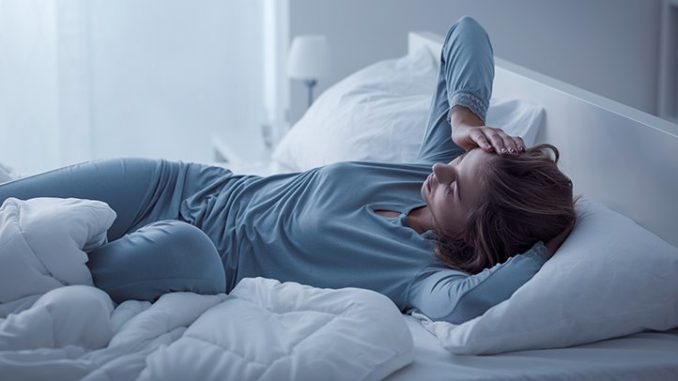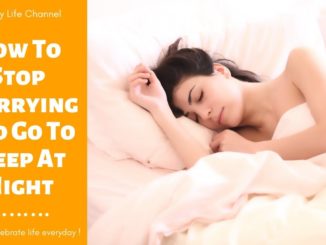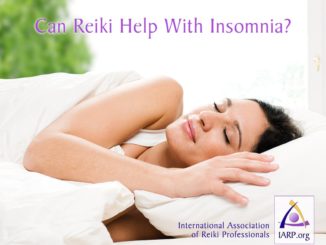
Insomnia is a sleep disorder in which one has difficulty falling asleep, staying asleep, or getting quality sleep. According to a recent study by the University of Pennsylvania School of Medicine, one in four Americans develop insomnia each year, but fortunately, about 75% of these individuals recover without developing persistent insomnia while the other 25% progress to acute insomnia.
People over the age of 60 tend to experience sleep disturbances more often than younger people. Females are also twice as likely to have sleep problems compared to males. There are a multitude of possible causes for insomnia, including:
- emotional stress,
- mental health disorders, such as depression or anxiety,
- chronic pain,
- allergies,
- asthma,
- heart failure,
- hyperthyroidism,
- heartburn,
- menopause,
- restless leg syndrome,
- circadian rhythm disruptions, such as jet lag or working night shifts,
- sleep apnea,
- certain medications,
- caffeine,
- heavy smoking, and
- excessive alcohol intake.
Insomnia is agonizing, exhausting, and frustrating. Some people turn to sleeping pills, either over-the-counter or prescription, which may help improve sleep while you are taking them. But insomnia usually returns once they are stopped because medications do not treat the underlying causes of insomnia.
Melatonin is a natural sleep hormone that is sold as a supplement. It is helpful for occasional sleep problems and jet lag. Individuals who report that melatonin does not work often make the mistake of taking too high a dose of several grams. Very often, as little as 300 mcg is already sufficient. Always start with the lowest dose before increasing the dosage. It is also beneficial to get the “timed release” melatonin as it will help you stay asleep longer. However, melatonin also does not address the underlying causes of insomnia.
A more successful approach to insomnia is to improve sleep hygiene and make lifestyle changes in conjunction with cognitive behavioral therapy. Dozens of studies have proved that this strategy is extremely helpful in treating insomnia. In the following, we will examine these techniques in more detail.
Sleep Hygiene And Lifestyle Changes
Sleep-Promoting Habits
The goal is to help you fall asleep more easily, wake up less often and for shorter periods of time, and fall back to sleep more easily.
- Regular rising time. Set an alarm clock and get out of bed around the same time every day, no matter how little or poorly you have slept. Do not try to sleep in on weekends because by doing so, you will disrupt your body’s circadian rhythm.
- Reducing time in bed. Do not go to bed early because you did not sleep well the prior night. This will actually exacerbate insomnia. Determine your earliest allowable bedtime by starting from your desired wake-up time and subtracting the amount of time you want to stay in bed. The time in bed is your average sleep time plus 1 hour and can range from a minimum of 6 hours to a maximum of 9 hours. If you sleep on average 5 hours or less at night, your time in bed should be 6 hours. If you sleep 8 hours, your time in bed should be 9 hours. In other words, your time in bed should closely match the amount of sleep you are averaging per night. The purpose is to avoid the bed becoming a cue for wakefulness more than a cue for sleep. For insomniacs who are already exhausted, the hardest part is to stay awake until the allowable bedtime. Try to engage in a light activity and refrain from going to bed. As you start to sleep better and more hours, you can move the allowable bedtime earlier.
- Wind down gradually in the hour before bedtime by engaging in relaxing activities. Avoid stimulating activities such as phone calls, arguments, emotional discussions, work-related activities, surfing the internet, bill-paying, or unpleasant TV programs.
- If you need to nap after a poor night of sleep, limit your nap to 45 minutes and do not take it later than 4 pm.
Stimulus-Control Methods
The purpose is to help insomniacs unlearn the connection between the bed and insomnia.
- Use the bed only for sleep and sex. No watching TV, working, studying, playing video games, or talking on the phone. If reading a book or watching TV helps you fall asleep, set a timer to turn off the light or TV after 30 minutes.
- If you cannot fall sleep within 30 minutes or if you awaken during the night and cannot fall back to sleep within that time, get up, go to another room, or sit in bed and engage in a quiet and relaxing activity such as reading a book or watching TV until you feel drowsy. Do not lie in bed tossing and turning.
Lifestyle Factors
- Engage in some form of physical activity every day. Apart from going to the gym, you can also include activities like washing the car, mowing the lawn with a non-riding mower, raking leaves, climbing stairs, bicycling, walking uphill, etc. These activities can be broken up into several shorter sessions but they should add up to at least 30 minutes each day. However, it is best not to exercise up to 3 hours before bedtime.
- Get some sunlight exposure during the day. If you work indoors, go outside on your coffee break or lunch hour. This will help regulate the body’s melatonin (sleep hormone) production and improve sleep. It will enhance your mood and energy as well.
- Drinking 1-2 cups of coffee early in the morning probably will not affect nighttime sleep. However, if you do not sleep well, you should avoid caffeine after noontime.
- If you smoke and cannot quit, try to eliminate smoking near bedtime or at night. Nicotine is a stimulant and it will make it harder to fall asleep and stay asleep.
- If you drink alcohol, limit yourself to one drink at least 2 hours before bedtime. Nightcaps are not a cure for insomnia. Alcohol makes it easier to fall asleep but it can make sleep lighter and more fragmented. It also suppresses deep sleep and exacerbates snoring and sleep apnea.
Food & Sleep Connection
- Foods that are high in complex carbohydrates (eg. peas, beans, oats, quinoa, brown rice) have a mild sleep-enhancing effect because they increase serotonin, a brain neurotransmitter that promotes sleep.
- Foods that are high in protein inhibit sleep by blocking serotonin.
- To fall asleep more easily and have less nighttime awakenings, try eating a light carbohydrate snack before bedtime.
- Avoid foods that are high in sugar as they can cause a burst of energy.
- Avoid foods that are likely to cause heartburn or any digestive discomfort.
- Avoid eating late dinners.
- Reduce fluid intake after 8 pm.
- Studies found that deficiencies in B vitamins can impair sleep. Consider taking a B complex supplement if you think that your diet may be lacking in nutrients.
Establishing The Optimal Sleep Environment
- Room temperature can have a significant impact on sleep. Insomnia is associated with a failure of body temperature to fall at bedtime. So sleeping in a warm room will make it even harder for the body temperature to drop. The optimal temperature for sleep is between 60 to 67 degrees Fahrenheit (or 16 to 19 degrees Celsius).
- Keep the bedroom completely dark and quiet. In general, insomniacs tend to be more sensitive to noise. Older people whose sleep is lighter as a consequence of aging are also more prone to noise-induced sleep disturbance.
- Some individuals are more sensitive to electromagnetic fields (EMFs) than others. If so, removing electronic devices from the bedroom can reduce the stimulation caused by EMFs.
- Make sure your bed is comfortable and provide adequate support. Beds that sag can disturb sleep by causing neck and back discomfort, while mattresses that are too hard can cause discomfort for people with arthritis.
Cognitive Behavioral Therapy For Insomnia (CBT-I)
CBT-I aims to treat chronic sleep problem by changing the thoughts and behaviors that cause or worsen sleep problems with habits that promote sound sleep.
Relaxation Training
Stressful life events are the most common precipitators of chronic insomnia. Most insomniacs and even some good sleepers have a harder time sleeping on stressful days. Studies have documented that increased daytime stress is correlated with reduced deep sleep, which results in lighter, more restless sleep.
Fortunately, we all have an inborn tool within us that can overcome these stress responses. It is called the relaxation response (RR), which simply put, is using the mind to control the body.
How To Induce The RR
- Lie down or sit comfortably. Relax all the muscles throughout the body by starting from the head spreading to the toes or vice versa.
- Engage in slow, deep abdominal breathing.
- Direct your attention from everyday thoughts to a neutral word such as calm, peace, relax, heavy or whatever you choose. Repeat the word silently. Or you can visualize an enjoyable, relaxing scene such as a beach, a mountain, a meadow, or floating on a cloud.
- If your mind wanders or negative thoughts come in, literally say “no thoughts” a few times. Then go back to your word or scene and continue with the deep breathing.
- Practice the RR everyday, either in the morning or afternoon. Allot 10-20 minutes for the RR. If you fall asleep, it is fine. However, do not practice the RR 1-2 hours before bedtime as it may affect your sleep.
- When you get better at doing the RR during the day, you can try using it at night to fall asleep or after a nighttime wake-up. If you do not fall asleep within 30 minutes. Get up or sit up in bed and engage in a light activity. Do not lie in bed tossing and turning.
- Be realistic and be patient. For some insomniacs, it takes up to a few weeks before their sleep improves.
Why The RR Improves Sleep
- When practiced during the day, it counters daily stress responses, reducing the likelihood that stress hormones will be elevated at night.
- When practiced at bedtime or after an awakening, it helps turn off the internal dialogue, quiet the mind, and relax the body.
- RR produces a brain-wave pattern similar to Stage 1 sleep, which is the transition state between waking and sleeping. When insomniacs practice the RR at night, it is easier to enter Stage 1 sleep and ultimately Stage 2, deep sleep, and dream sleep.
How To Overcome Negative Self-Talk
Last but not least, negative thoughts during the day or at bedtime play a powerful role in stimulating wakefulness and causing insomnia. Certain negative thoughts and emotions are normal responses to stressful situations, such as grieving after a death. However, some negative emotions such as worry, anxiety, frustration, and anger are unnecessary, excessive, and unhealthy. They trigger stress responses that adversely affect sleep. Therefore, it is beneficial to eliminate or restructure these negative thoughts that cause more stress.
- Become more aware of negative self-talk. Catch yourself doing it or better, write them down and review them at the end of the day.
- Realize that most of these thoughts are either not true or overly negative and pessimistic.
- Reflect on past experiences and ask yourself: “Has anything like this happened to me in the past and if so, how did it turn out?” Most likely, we tend to worry too much and things seldom turn out as badly as we imagined.
- Reframe your negative thoughts and focus on positive beliefs.
- Do not generalize a problem to your whole life. View setbacks as temporary.
- Avoid blaming yourself for things beyond your control.
- Refrain from dismissing positive events as temporary or due to luck or external causes.
- Practice gratitude everyday.
- Seek out optimists and avoid pessimists. Both optimism and pessimism are contagious.
Hopefully, by incorporating healthy sleep hygiene and making lifestyle changes as well as cognitive behavioral therapy, we can all say goodnight to insomnia!
Proudly WWW.PONIREVO.COM
by Carol Chuang



